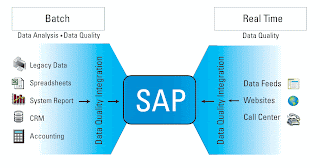 SAP will have to address potential conflicts of interest between its partners and its own ambitions. Asked about possible differences between players in the market and SAP, on the occasion of a new version could literally wiped off the map all the partners who offer a process covered by the basic package, the head is reassuring: We think in fact in this case, For example we might offer our partners a new commitment to 12 months forcing us not to launch the process directly competing offers. This is a point still under consideration.
SAP will have to address potential conflicts of interest between its partners and its own ambitions. Asked about possible differences between players in the market and SAP, on the occasion of a new version could literally wiped off the map all the partners who offer a process covered by the basic package, the head is reassuring: We think in fact in this case, For example we might offer our partners a new commitment to 12 months forcing us not to launch the process directly competing offers. This is a point still under consideration.Governance To Discover For SAP
 SAP will have to address potential conflicts of interest between its partners and its own ambitions. Asked about possible differences between players in the market and SAP, on the occasion of a new version could literally wiped off the map all the partners who offer a process covered by the basic package, the head is reassuring: We think in fact in this case, For example we might offer our partners a new commitment to 12 months forcing us not to launch the process directly competing offers. This is a point still under consideration.
SAP will have to address potential conflicts of interest between its partners and its own ambitions. Asked about possible differences between players in the market and SAP, on the occasion of a new version could literally wiped off the map all the partners who offer a process covered by the basic package, the head is reassuring: We think in fact in this case, For example we might offer our partners a new commitment to 12 months forcing us not to launch the process directly competing offers. This is a point still under consideration.Posted by sharvan at 5:41 AM Labels: about sap, Business Software, ERP SAP, sap, SAP Netweaver 0 comments
A Logical Extension Of Business In SAP
 There are to date more than 400 applications developed for Business One partners, argues Luis Murguia, senior vice president of SAP for Europe. Since the advanced warehouse management to enterprise resource planning to farm salmon, from the rum distillery, the most diverse solutions have emerged about Business One. There on the market today to a war between ecosystems. And it is he who will have the expertise to win this war. This ecosystem, SAP will attempt to recreate in its cloud offering.
There are to date more than 400 applications developed for Business One partners, argues Luis Murguia, senior vice president of SAP for Europe. Since the advanced warehouse management to enterprise resource planning to farm salmon, from the rum distillery, the most diverse solutions have emerged about Business One. There on the market today to a war between ecosystems. And it is he who will have the expertise to win this war. This ecosystem, SAP will attempt to recreate in its cloud offering.Posted by sharvan at 5:24 AM Labels: Business Software, ERP SAP, SAP Module, SAS 0 comments
SAP Preparing A Cloud To Expand Its SaaS Offering
 On the model of Salesforce's, SAP is developing its cloud offering to create and support an ecosystem of partners around its ERP for SME, SAP Business ByDesign. It was during a European event dedicated to SMEs, senior vice president in charge of SAP's strategy of SMEs has missed the information: "We will provide a development environment for SAP Business ByDesign".
On the model of Salesforce's, SAP is developing its cloud offering to create and support an ecosystem of partners around its ERP for SME, SAP Business ByDesign. It was during a European event dedicated to SMEs, senior vice president in charge of SAP's strategy of SMEs has missed the information: "We will provide a development environment for SAP Business ByDesign".Not only it will soon be possible to develop applications for SAP Business ByDesign, but it will run on the platform Saas SAP. Finally, a marketplace will be launched for the publishing partners can market their achievements.
But it was in 2010 that SAP Business ByDesign will know his true revolution. The ERP giant will expand the number of countries where supply is available, but above all he is planning to open its Saas platform to third party publishers. They will publish extensions to Business ByDesign to extend its functional coverage, to meet specific needs, a step he took on Business One, its software package for SMEs.
Posted by sharvan at 4:57 AM Labels: about sap, ERP SAP, SAP Module, SAS 0 comments
Integration Of SAP BW And BO
Posted by sharvan at 5:18 AM Labels: Business Software, ERP SAP, SAP BW and BO 0 comments
SAP BI RoadMap
 Reporting solutions from Business Objects as a basis for future development (WebIntelligence, Crystal Xcelsius, Voyager). The best of Business Explorer Analyzer will be combined to create the future analysis tool, "Pioneer" for 2010.
Reporting solutions from Business Objects as a basis for future development (WebIntelligence, Crystal Xcelsius, Voyager). The best of Business Explorer Analyzer will be combined to create the future analysis tool, "Pioneer" for 2010. Posted by sharvan at 5:03 AM Labels: about sap, Business Software, EPR SAP, SAP BI 0 comments
What Effects For Microsoft?
 It is the first time a major publisher announced that it reduces the wing in the coveted field of Business Intelligence, which all analysts are predicting it will be one of the main engines of growth information. This perspective is also the origin of concentrations, including the acquisition of Business Objects by SAP is one of the most prominent.
It is the first time a major publisher announced that it reduces the wing in the coveted field of Business Intelligence, which all analysts are predicting it will be one of the main engines of growth information. This perspective is also the origin of concentrations, including the acquisition of Business Objects by SAP is one of the most prominent. Posted by sharvan at 4:14 AM Labels: about sap, Business Software, computer, Facts, Microsoft 0 comments
Managing Permissions Roles To The SAP Users
 Managing permissions in SAP NetWeaver BI can restrict user access. These limitations apply to both the possible actions (or launch a state change, etc.), functional domains available (represented by cubes), and the scope of analysis (such society, country, etc.).
Managing permissions in SAP NetWeaver BI can restrict user access. These limitations apply to both the possible actions (or launch a state change, etc.), functional domains available (represented by cubes), and the scope of analysis (such society, country, etc.).Posted by sharvan at 4:56 AM Labels: about sap, EPR SAP, sap, SAP Basis, SAP BI, SAP Netweaver 0 comments
Features Of Xcelsius
 Among the different ways of information, the dashboards are a priori more obvious and simple. These indicators represent the key graphs and tables. The most common tool to do this is Excel, which provides flexibility of implementation but prohibits implementation in a complex environment, and automatically shared.
Among the different ways of information, the dashboards are a priori more obvious and simple. These indicators represent the key graphs and tables. The most common tool to do this is Excel, which provides flexibility of implementation but prohibits implementation in a complex environment, and automatically shared.- The data used by the graphics are ultimately stored in an Excel integrated, which allows great flexibility, modeling of complex calculations and powerful interactions with the user.
- This is an open solution that can be supplied by several sources, such as the universe via LiveOffice or web services.
- It can be used standalone or with a BOE server (for access via the portal Infoview).
- The result is represented by a Flash file that contains the objects, connections, modeling, Excel, etc.. This file is portable and can be integrated both into a ppt presentation on a html page.
- The dashboard can be composed of many elements interacting with each other, and which may set the behavioral format .. (lists, buttons, tables, etc., etc.).
- Rendering in flash is very good and allows for example animations, interactions, selections, etc..
- Creating a dashboard is made by KeyUsers and not by users themselves.
Posted by sharvan at 4:25 AM Labels: Business Software, sap, SAP Xcelsius 0 comments
Server Visualization Benefits For Businesses
 The idea of this concept rests on the possibility of dispersing an information system infrastructure around the world. So, shared computing power and memory of computers and servers located anywhere in the world. These virtual resources are linked through the Internet and thus created a huge computer network and scalable. This computing can be dissociated from one approach to SOA (Service-Oriented Architecture).
The idea of this concept rests on the possibility of dispersing an information system infrastructure around the world. So, shared computing power and memory of computers and servers located anywhere in the world. These virtual resources are linked through the Internet and thus created a huge computer network and scalable. This computing can be dissociated from one approach to SOA (Service-Oriented Architecture).Posted by sharvan at 6:12 AM Labels: about sap, Business Software, Server 0 comments
SAP Web Applications Runs
 Once the applications are built, it is possible to execute in the SAP Portal which particularly in management of business roles and access rights. It is also possible to run the Web Dynpro in on-line mode on mobile. To migrate an interface "PC" to interface "Mobile", it should only adjust the interface.
Once the applications are built, it is possible to execute in the SAP Portal which particularly in management of business roles and access rights. It is also possible to run the Web Dynpro in on-line mode on mobile. To migrate an interface "PC" to interface "Mobile", it should only adjust the interface.
- CBS - (This is the part that will build your archive)
- CMS - (This is the part that will transport components of your environment to another)
- DTR - (Which is the repository will store your developments and manage the version)
- LTC - (It is here that you will define your configuration and WAS systems, use ECC)
Posted by sharvan at 5:30 AM Labels: about sap, Business Software, ERP SAP, sap 0 comments
SAP WORLD
 SAP offers through the SAP NetWeaver platform all the components necessary to build a Web application and its exposure mode Intranet or Internet. SAP provides various tools for developing user interface WEB application.
SAP offers through the SAP NetWeaver platform all the components necessary to build a Web application and its exposure mode Intranet or Internet. SAP provides various tools for developing user interface WEB application.- Web Dynpro - ABAP: Web Dynpro proposes a model of modeling language (metamodel) for the uniform construction of all user interface that accelerates development. Web Dynpro strictly separates the presentation layer and business data (MVC). SAP Web Dynpro technology communicates with Adobe Flex / Flash and allows the construction of interfaces 2.0.
- Web Dynpro - JAVA: The major differences with the version of ABAP, The development environment is not the same one side Java based on NWDI and NWDS unlike the WD ABAP it is via the SE80, Access to data is native.
- VISUAL COMPOSER: Visual Composer allows you to compose applications without requiring to code. Ergonomics is based on standard flash libraries. The possibilities of implementations are limited to the models provided by SAP.
- BSP - HTMLB: This technology combines the ABAP programming languages, HTML and javascript. It is very open and allows all the creative liberties on SAP WebAS. It is possible to develop using the MVC but not an obligation. The technology exists on installer's. It is to recommend for further development of a Web application on SAP.
Posted by sharvan at 4:29 AM Labels: about sap, Business Software, ERP SAP, sap 0 comments
Trends In The Evolution Of Business Intelligence
 First, publishers trend to provide users with greater autonomy. From a DataWarehouse structured, each user must construct its statements independently. This concerns the reporting and additional applications such as budgeting. This trend is not without risk (inconsistent statements, management of entitlements, performance, no "single vision of truth" ...) but meets a real need from users.
First, publishers trend to provide users with greater autonomy. From a DataWarehouse structured, each user must construct its statements independently. This concerns the reporting and additional applications such as budgeting. This trend is not without risk (inconsistent statements, management of entitlements, performance, no "single vision of truth" ...) but meets a real need from users.Posted by sharvan at 5:35 AM Labels: about sap, EPR SAP, sap, SAP Basis, SAP BI, SAP Module 0 comments
The Future Of Business Intelligence
 The needs for business to know their environment and to identify opportunities and risks has given rise to practices of economic intelligence. Analyze the legal, fiscal, geopolitical, financial and especially trading is widespread. Now it combines the concept of risk management, which is a natural extension.
The needs for business to know their environment and to identify opportunities and risks has given rise to practices of economic intelligence. Analyze the legal, fiscal, geopolitical, financial and especially trading is widespread. Now it combines the concept of risk management, which is a natural extension.Often there is confusion between the practices and objectives of business intelligence and tools to implement to achieve this. Indeed, monitor performance requires first to be able to collect raw data, wherever they are, and present them to users in the form that suits them to the best. The business intelligence tools fulfill this task, and there are usually three levels:
- Data collection and processing into usable information is provided by ETL (extraction, transformation, loading).
- Storage and modeling in a form compatible with the tools of recovery are provided by the DataWarehouse
- The return on the screen of the user reporting tools - dashboards, analysis in Excel or in Web reports in a list, etc.
Posted by sharvan at 4:58 AM Labels: about sap, Business Software, ERP SAP, sap, SAP BI 0 comments
Integration Into SAP Portal
 The Integration Kit provides a planned iView to display content BOE. It is easy to embed Crystal Reports, Travel, Web Intelligence and Xcelsius. Simply choose the iView "Standard BusinessObjects Enterprise Report" and the ID information of the BOE report.
The Integration Kit provides a planned iView to display content BOE. It is easy to embed Crystal Reports, Travel, Web Intelligence and Xcelsius. Simply choose the iView "Standard BusinessObjects Enterprise Report" and the ID information of the BOE report.Posted by sharvan at 5:38 AM Labels: about sap, EPR SAP, sap, SAP Portal 0 comments
The Integration Of SAP NetWeaver BI and Business Objects
 This part is designed for SAP customers wishing to make and distribute their reporting on the data stored in SAP solutions using BusinessObjects tools. The main potential of this integration are,
This part is designed for SAP customers wishing to make and distribute their reporting on the data stored in SAP solutions using BusinessObjects tools. The main potential of this integration are,Posted by sharvan at 4:22 AM Labels: EPR SAP, sap, SAP BI, SAP Netweaver 0 comments
Scope & Limits of BusinessObjects Explorer
Posted by sharvan at 5:56 AM Labels: Business Software, EPR SAP, sap, SAP Basis 0 comments
BusinessObjects Explorer
 Business Objects Explorer allows you to search a data set through a search engine and lists.
Business Objects Explorer allows you to search a data set through a search engine and lists.
Posted by sharvan at 5:07 AM Labels: Business Software, EPR SAP, sap 0 comments
Effects Of RoadMap In BI
 Effects of RoadMap and Perspectives:
Effects of RoadMap and Perspectives:
Posted by sharvan at 5:55 AM Labels: EPR SAP, sap, SAP BI, SAP Module 0 comments
The Evolution Of Business Intelligence At SAP
 Evolution Of Business Intelligence:
Evolution Of Business Intelligence:
Posted by sharvan at 5:32 AM Labels: Business Software, EPR SAP, sap, SAP BI 0 comments
SAP NW Resumes All Technologies
SAP NetWeaver resume all technologies and strategies: 
- Business Services - (Pre-packaged, Business Packages, Web ...)
- Standards and open technology - (industry standards, interoperability, industry standard ...)
- ABAP and JAVA technologies - (SAP kernel, portal, eCommerce, services and developments)
- Security - (Identity, authorization, encryption, SSO, Network Security ...)
- Internationalization - (multilingual adaptation process to the country, legal obligations ...)
- Interoperability with market tools - (Microsoft. NET, IBM WebSphere ...)
- Monitoring and Diagnostics environments - (BI Solution Manager and Alerting, Monitoring ...)
Posted by sharvan at 6:23 AM Labels: about sap, Business Software, ERP SAP, sap, SAP Netweaver 0 comments
SAP NetWeaver Offers
 SAP NetWeaver is the technical platform upon which is common to all of the applications offer SAP Business Suite. It includes an offer of Process Integration EAI / ESB (SAP PI), an offer of Business Intelligence (SAP BI ), offers a Master Data Management (SAP MDM) offers a portal (SAP EP) and offering mobility. This base is open to industry standards and delivers SAP solutions to be interoperable with other environments and technical applications (eg: Microsoft. NET, Sun Java EE, IBM WebSphere, Oracle / BEA).
SAP NetWeaver is the technical platform upon which is common to all of the applications offer SAP Business Suite. It includes an offer of Process Integration EAI / ESB (SAP PI), an offer of Business Intelligence (SAP BI ), offers a Master Data Management (SAP MDM) offers a portal (SAP EP) and offering mobility. This base is open to industry standards and delivers SAP solutions to be interoperable with other environments and technical applications (eg: Microsoft. NET, Sun Java EE, IBM WebSphere, Oracle / BEA). - Finally, SAP Netweaver provides enterprises a robust and stable foundation for SOA (Service-Oriented Architecture) by providing a particular integrated development environment for building composite applications.
Posted by sharvan at 6:06 AM Labels: about sap, Business Software, EPR SAP, sap, SAP Netweaver 0 comments
SAP BI - Business Intelligence
 SAP BI (Business Intelligence) is the SAP solution dedicated to reporting the decision-making built around a data warehouse tools and restitution. These tools allow both the development of multidimensional analysis that flexible dashboard complex combination of multiple functional areas and integrate seamlessly within the supply SAP Netweaver.
SAP BI (Business Intelligence) is the SAP solution dedicated to reporting the decision-making built around a data warehouse tools and restitution. These tools allow both the development of multidimensional analysis that flexible dashboard complex combination of multiple functional areas and integrate seamlessly within the supply SAP Netweaver.Posted by sharvan at 5:29 AM Labels: about sap, Business Software, EPR SAP, sap, SAP BI 0 comments







